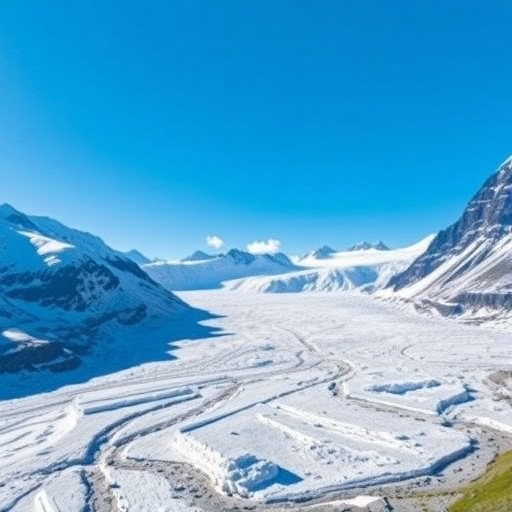Despite the global spotlight on glacier preservation declared by the United Nations International Year of Glaciers, Switzerland has recorded yet another alarming year of glacier melt in 2025. The alpine glaciers that blanket this mountainous country have witnessed a severe reduction in ice mass, echoing the catastrophic losses observed in recent years, especially 2022, 2023, and the historic heatwave year of 2003. This relentless ice retreat is not just a seasonal anomaly but an indicator of accelerating climatic shifts impacting the cryosphere profoundly.
Throughout the winter of 2024/2025, unsatisfactory snowfall combined with unprecedented warmth laid the groundwork for an early and extensive melt season. Weather records show this winter experienced the third warmest October to March period since measurements began, coupled with significantly diminished precipitation levels. This disrupted the delicate snow-ice balance essential to glacier sustenance. Snow reserves, typically accumulating and replenishing glacier mass, were depleted by mid-summer, triggering an exceptionally early onset of melting processes.
The case of the Claridenfirn glacier in Canton Glarus exemplifies the severity of this transformation. Once cloaked in thick winter snow layers, the 2025 season saw it entirely free of snow by September, a phenomenon scarcely witnessed before. Similarly, the Plaine Morte Glacier in Bern and the Silvretta Glacier in the Grisons have experienced ice thickness reductions exceeding two meters. In contrast, glaciers in the southern Canton of Valais, such as Findel and Allalin, saw slightly less drastic losses nearer to one meter, indicating regional variations possibly influenced by microclimates and local elevation.
Analyses conducted by the Glacier Monitoring in Switzerland (GLAMOS) program reveal that Swiss glaciers have lost nearly 25% of their volume since 2015, an extraordinary decline given the relatively short timeframe. Over a thousand smaller glaciers have vanished altogether, indicating a dramatic reshaping of the alpine landscape. These rapid losses position the decade as the period with the most accelerated glacier melt on record, underscoring the urgency of climate action.
The high-altitude snowpack that typically serves as a natural reservoir for glaciers suffered profound deficits this year. Reduced snowfall depth was particularly significant in the northern and central regions of the Grisons, where meteorological stations reported some of the lowest accumulations ever recorded. Correspondingly, by late April 2025, snow cover on glaciers was approximately 13% lower than the average recorded between 2010 and 2020, jeopardizing the seasonal ice balance and exacerbating summer melt risks.
The summer months intensified the melting trend with a notable heatwave in August, where zero-degree Celsius lines soared to elevations above 5,000 meters, a stark anomaly for the Alpine environment. Despite intermittent cold fronts delivering some snowfall above 2,500 meters between July and September, these events were insufficient to offset overall melting. The episodic snow cover in higher altitudes was transient and failed to provide long-term ice regeneration.
The interrelation between diminishing glaciers and alpine slope stability has emerged as a consequential hazard. Matthias Huss, Director of GLAMOS, points to the destabilizing effects of glacier retreat on mountain structures. The collapse of ice and rock in the Lötschental valley, which caused an avalanche devastating the village of Blatten, exemplifies the cascading risks posed by ongoing cryospheric changes. Such events highlight glacier melt’s broader implications for human safety and infrastructure resilience in mountainous regions.
Long-term observations underscore that glacier melt is not solely a function of rising temperatures but is intricately linked with seasonal precipitation patterns, snowpack accumulation, and atmospheric circulation changes. The decline in snow reserves triggers a feedback mechanism where exposed glacier ice absorbs more solar radiation, accelerating melt rates. This feedback loop threatens to precipitate even faster ice mass losses if warming trends persist unmitigated.
The Swiss Commission for Cryosphere Observation (SCC) integrates nationwide efforts to monitor this evolving situation, coordinating among research institutions including the Swiss Federal Institute for Forest, Snow and Landscape Research (WSL), the Institute for Snow and Avalanche Research (SLF), and universities such as ETH Zurich and the University of Fribourg. This collaborative network ensures comprehensive data gathering on snow, glacier dynamics, and permafrost changes vital for predictive modeling and risk assessments.
Technological advancements under the GLAMOS program facilitate precise mass balance measurements through remote sensing, ground-penetrating radar, and geodetic surveys. These tools enable scientists to quantify ice thickness changes with high accuracy and track subtle shifts in glacier geometry over time. Combining these methods supports more nuanced understanding of glacier responses to atmospheric forcing and guides policy frameworks addressing climate mitigation.
The continuing loss of Swiss glaciers carries profound environmental, ecological, and socioeconomic consequences. Hydrological cycles that rely on glacier-fed water sources are increasingly disrupted, impacting freshwater availability for agriculture, hydropower, and municipal use. The loss of this cryospheric store threatens biodiversity in alpine ecosystems, dependent on cold environments and seasonal water inputs. Moreover, cultural and recreational identities tied to these ancient ice formations face tangible erosion.
Urgent, coordinated global action is imperative to slow glacier retreat and preserve remaining ice masses. Though Switzerland operates at the forefront of cryosphere monitoring and climate research, the accelerating pace of glacier loss within its borders exemplifies the planetary scale of climate disruption. In-depth scientific inquiry combined with policy intervention and public engagement remains essential to curb further irreversible transformations of the alpine cryosphere.
In summary, the year 2025 marks another significant chapter in the ongoing story of glacier melt in Switzerland, reinforcing alarming trends observed in recent decades. The interplay of warm winters, scarce snowfall, and intensified summer heatwaves continues to degrade ice masses with unprecedented rapidity. Scientists emphasize that without swift emissions reductions and adaptive strategies, the trajectory of alpine glacier retreat threatens to reshape not just the Swiss Alps, but global natural systems reliant on mountain hydrology and climate stability.
Subject of Research: Not applicable
Article Title: Glaciology Report: And Swiss glaciers continue to melt
News Publication Date: 1-Oct-2025
Web References: https://www.glamos.ch/en/
Image Credits: Matthias Huss / VAW / ETH Zurich
Keywords: glacier melt, Switzerland, glacier monitoring, GLAMOS, climate change, alpine glaciers, ice loss, cryosphere, snowpack deficit, heatwaves, permafrost, mountain stability




